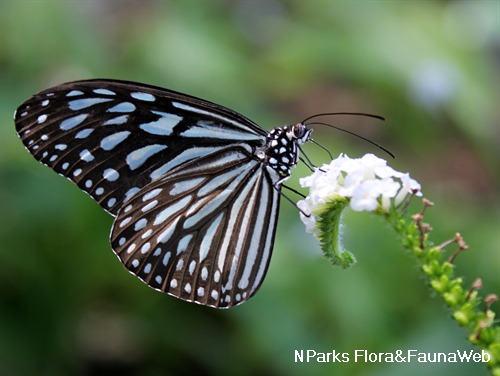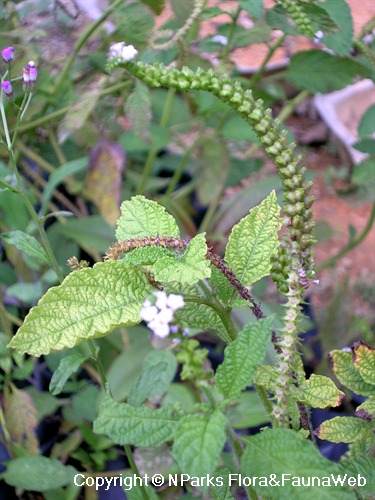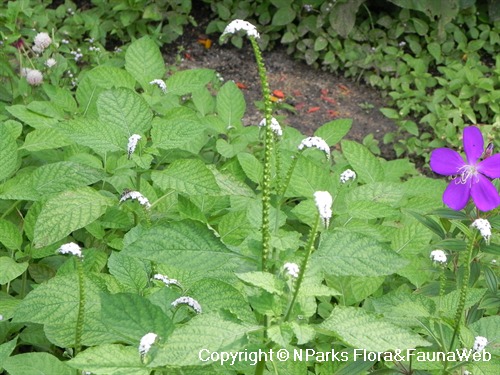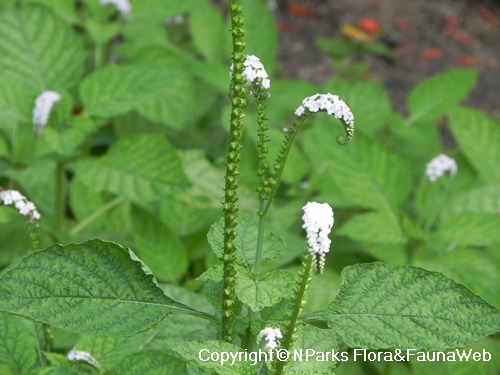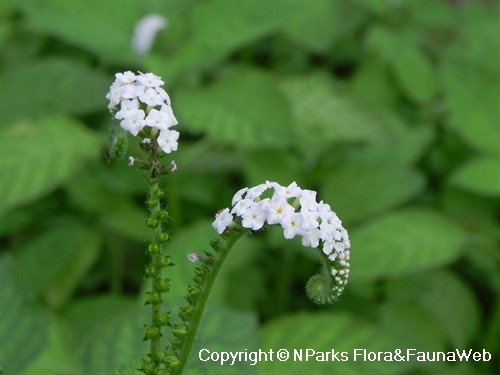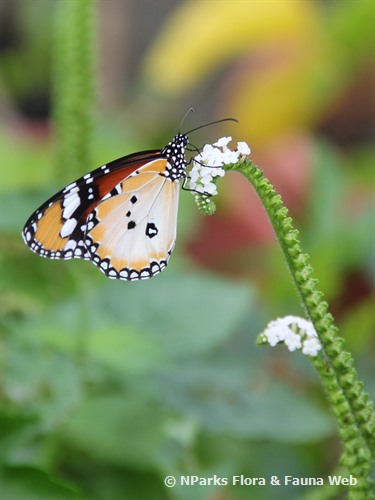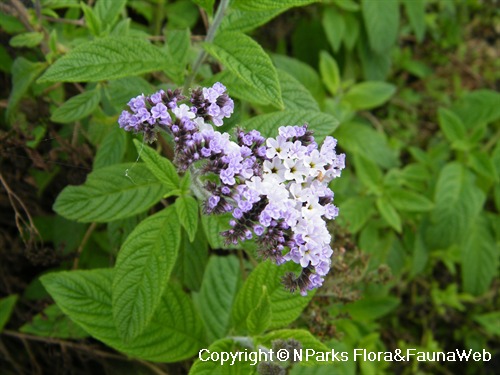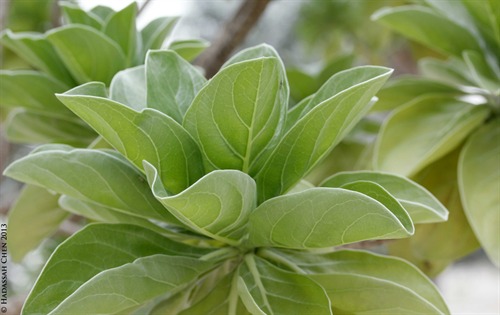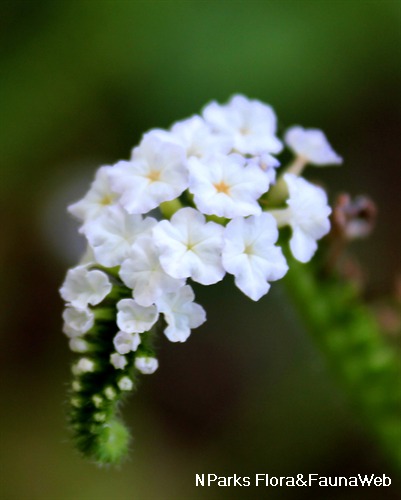
Back
Heliotropium indicum L.
| Family Name: | Boraginaceae |
| Synonyms: | Tiaridium indicum, Heliophytum |
| Common Name: | Indian Turnsole, Indian Heliotrope, 大尾摇 |
Name
Classifications and Characteristics
| Plant Division | Angiosperms (Flowering Seed Plants) (Dicotyledon) |
|---|---|
| Plant Growth Form | Shrub |
| Lifespan (in Singapore) | Annual |
| Mode of Nutrition | Autotrophic |
| Maximum Height | 0.2 m to 0.5 m |
Biogeography
| Native Distribution | Pan-tropical - probably South America & tropical Asia, including Singapore |
|---|---|
| Native Habitat | Terrestrial (Secondary Rainforest, Riverine, Disturbed Area / Open Ground) |
| Preferred Climate Zone | Tropical |
Description and Ethnobotany
| Growth Form | Annual herb with erect growth form. |
|---|---|
| Foliage | Leaves are egg-shaped to oblong (3-9 cm long, 2-4 cm wide) with a wavy leaf margin. Leaf surface is covered in short hairs which may be quite stiff. The leaf blade extends down the length of the petiole. Leaf arrangement is alternate (one leaf per node on alternating sides of the stem) or subopposite (leaves are nearly paired but slightly set apart). |
| Flowers | Small flowers (3-4 mm wide) are light purple or white with a yellow centre. They are salverform, having a narrow tube with lobes forming a plate-like shape that is perpendicular to the tube. The narrow inflorescence resembles a string of beads with a distinct curl at the tip. Only a small number of flowers open slightly below the tip of the inflorescence. |
| Fruit | Dry, indehiscent fruits are known as nutlets. They are egg-shaped and beaked (4-5 mm long). |
Landscaping Features
| Thematic Landscaping | Butterfly Garden |
|---|
Fauna, Pollination and Dispersal
| Fauna Pollination Dispersal Associated Fauna | Butterfly-Attracting, Butterfly Host Plant, Bee-Attracting |
|---|---|
| Pollination Method(s) | Biotic (Fauna) (Insects (Butterfly, Moth)) |
Plant Care and Propagation
| Light Preference | Full Sun, Semi-Shade |
|---|---|
| Water Preference | Lots of Water, Moderate Water |
| Plant Growth Rate | Fast |
| Rootzone Tolerance | Poor Infertile Soils, Waterlogged Soils (Drains Site) |
| Propagation Method | Seed |
Foliar
| Foliage Retention | Evergreen |
|---|---|
| Mature Foliage Colour(s) | Green |
| Mature Foliage Texture(s) | Hairy / Hirsute, Raised / Sunken Veins |
| Foliar Type | Simple / Unifoliate |
| Foliar Arrangement Along Stem | Alternate |
| Foliar Attachment to Stem | Petiolate |
| Foliar Shape(s) | Non-Palm Foliage (Ovate, Oblong) |
| Foliar Venation | Pinnate / Net |
| Foliar Margin | Entire - Wavy / Undulate, Serrate / Toothed |
| Foliar Apex - Tip | Acute |
| Foliar Base | Rounded / Obtuse, Truncate / Square, Oblique / Asymmetrical |
| Typical Foliar Area | Microphyll ( 2.25cm2 - 20.25 cm2 ) |
Non - Foliar and Storage
| Root Type | Underground (Fibrous Root) |
|---|
Floral (Angiosperm)
| Flower & Plant Sexuality | Bisexual Flowers |
| Flower Colour(s) | Purple, White, Yellow / Golden |
|---|---|
| Flower Grouping | Cluster / Inflorescence |
| Flower Location | Terminal |
| Flower Symmetry | Radial |
| Individual Flower Shape | Salverform |
| Inflorescence Type | Cyme |
| Ovary Position | Superior / Hypogynous |
| Flowering Period | Free-Flowering |
| Flowering Opening Time | Time-Independent |
| Flowering Habit | Polycarpic |
Fruit, Seed and Spore
| Mature Fruit Colour(s) | Brown |
|---|---|
| Fruit Classification | Simple Fruit |
| Fruit Type | Indehiscent Dry Fruit , Nut / Nutlet |
Image Repository
Others
| Master ID | 29120 |
|---|---|
| Species ID | 3429 |
| Flora Disclaimer | The information in this website has been compiled from reliable sources, such as reference works on medicinal plants. It is not a substitute for medical advice or treatment and NParks does not purport to provide any medical advice. Readers should always consult his/her physician before using or consuming a plant for medicinal purposes. |

